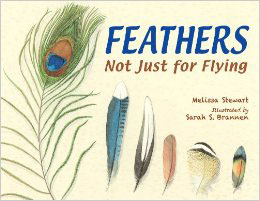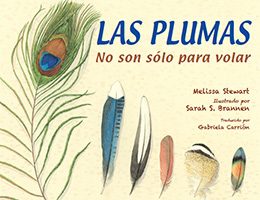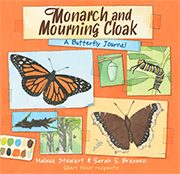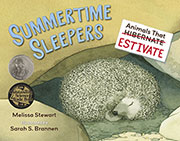Feathers
Not Just for Flying


by Melissa Stewart
illus by Sarah S. Brannen
Charlesbridge, 2014
for ages 5 to 9
ISBN 978–1‑58089–430‑2 (HC)
ISBN 978–1‑58089–431‑9 (PB)
Purchase this book at your local independent bookseller or Amazon.com.

ISBN 978–162354-601–4 (HC)
Feathers aren’t just for flying. They can also protect a bird’s skin like sunscreen, attract attention like fancy jewelry, or even distract a predator like a bullfighter’s cape. Feathers: Not Just for Flying introduces young readers to sixteen birds, from the sleek emperor penguin to the fluffed-up blue jay and describes just how positively practical feathers can be.
Honors and Awards
- AAAS Books for Children Holiday Gift Guide
- ALA Notable
- Animal Behavior Society’s Outstanding Children’s Book Award Finalist
- Authors for Earth Day’s Eco Book of the Month
- Bulletin of the Center for Children’s Books Blue Ribbon Title
- Chicago Public Library Best Informational Books for Young Readers
- Cybils Award
- Illinois Monarch Award Master List
- International Literacy Association Teacher’s Choices Reading List
- John Burroughs Riverby Award
- Junior Library Guild Selection
- Kiss the Book’s Top 50 Books for Elementary
- Maryland Black-Eyed Susan Book Award Nominee
- Massachusetts Center for the Book, Highly Recommended
- National Science Teachers Association—
Children’s Book Council Outstanding Science Trade Book - Nerdy Book Club Award
- New York Public Library’s Best Books of the Year (Spanish edition)
- Nonfiction Detectives Best Books of the Year
- NYC Reads 365 Recommended Reading List
- Pennsylvania Keystone to Reading Award Nominee
- Publishers Weekly, starred review
- Read Across America Featured Title
- SCBWI Crystal Kite Award
- Science Books & Films Best Books of the Year
- Tennessee Volunteer State Book Award Nominee
- Virginia’s Capitol Choices’ Noteworthy Title for Children and Teens
- Washington State Towner Award Nominee
Reviews
“Feathers are not only a means of avian locomotion—they also have many secondary purposes for birds. “Feathers can warm like a blanket… or cushion like a pillow,” writes Stewart. “Feathers can shade out sun like an umbrella… or protect skin like sunscreen.” Making skillful use of trompe l’oiel, Brannen’s delicate, refined watercolors give the project the feel of a birders’ scrapbook, as though the feathers, “photographs,” informational notes, and other ephemera that appear have been taped, stapled, and clipped to the pages (one note even has a telling coffee cup stain). A focused and thorough examination that highlights the striking beauty of these often-unnoticed natural objects.” (Publishers Weekly, starred review)
“Feathers are deceptively simple marvels of adaptation, providing not just locomotion for birds, but also protection, warmth, decoration, and comfort. This book celebrates the amazing versatility of these easily recognizable objects, which young readers might find right in their own backyards. Vividly rendered watercolor illustrations of feathers in life-sized scale complement the straightforward text that describes 16 species of birds and the unexpected functions of their feathers. Common birds, such as jays, cardinals, penguins, and swans, share pages with more exotic species, like the rosy-faced lovebird of Namibia and a type of sandgrouse found in the Gobi Desert. Stewart describes how chicks suck on the wet feathers of their parents to quench their thirst and how males of some species can play a type of high-pitched, squeaky love song by shaking their wings to attract female mates. Part science journal, part read-along nonfiction, Feathers succeeds in what such science books for young readers should strive to do: help young minds spot the extraordinary in the seemingly mundane.” (Booklist)
“Feathers are deceptively simple marvels of adaptation, providing not just locomotion for birds, but also protection, warmth, decoration, and comfort. This book celebrates the amazing versatility of these easily recognizable objects, which young readers might find right in their own backyards. Vividly rendered watercolor illustrations of feathers in life-sized scale complement the straightforward text that describes 16 species of birds and the unexpected functions of their feathers. Common birds, such as jays, cardinals, penguins, and swans, share pages with more exotic species, like the rosy-faced lovebird of Namibia and a type of sandgrouse found in the Gobi Desert. Stewart describes how chicks suck on the wet feathers of their parents to quench their thirst and how males of some species can play a type of high-pitched, squeaky love song by shaking their wings to attract female mates. Part science journal, part read-along nonfiction, Feathers succeeds in what such science books for young readers should strive to do: help young minds spot the extraordinary in the seemingly mundane.” (School Library Journal)
“An album of images and a simple text reveal that birds’ feathers are far more versatile than one might expect. Comparing feathers to familiar objects, Stewart reveals that birds use them in surprising ways. Her two-level text is headlined with a comparison and includes a short paragraph of explanation. Laid out like a scrapbook, her words share a page or spread with accurate and appealing watercolor images of a bird (identified by species and location), the everyday object in question and the feather…. considerable research by both author and illustrator is evident. The combination of thoughtful approach and careful crafting makes this an excellent resource for early nature study.” (Kirkus Reviews)
“Birds and the remarkable variety of their feathers are the focus of this beautifully illustrated volume. On each double-page spread, the simple main text (in larger font) points out the primary functions of the featured feathers, while text boxes present facts specific to the representative species featured, along with small images of objects used by humans that are analogous to each feather’s purpose (e.g., sun block, life jacket, umbrella). Brannen’s delicate watercolors include pictures of birds in action using their feathers for various purposes as well as wonderfully detailed close-ups of the feathers themselves.” (The Horn Book)
“Beautiful and concise, this is an excellent resource for units on animal adaptation, and a treat for the youngest bird lovers.” (Bulletin of the Center for Children’s Books)
“If you know birders, this book is perfect for them.” (Chicago Post-Tribune)
“Melissa Stewart has created another masterful book on the wonders and many uses of feathers. Each use is illustrated with species and specific details. The back matter has details regarding kinds of feathers and a write up by the author provides more information for education. Teachers can use this book as a virtual field trip in the classroom.” (Reading Today)
“[Stewart’s] use of metaphors to show what feathers do is an inspired choice, making the book all the more accessible for children…. The watercolor illustrations are done to look like a naturalists field journal with scraps of paper, loose feathers, notes, cup rings, and scraps of fabric. The result is a richly visual book that will instruct and amaze, just the right sort of science book for young readers. Appropriate for ages 6–9.” (Read the full review.) (Waking Brain Cells)
“Feathers: Not Just for Flying by Melissa Stewart with illustrations by Sarah S. Brannen is one of my favorite nonfiction titles of 2014. The mix of narrative and visuals is as pleasing as watching a feather floating on a current of air; light, airy and down-to-earth. In addition to the author’s note two pages are devoted to classifying feathers; six categories are described.” (Read the full review.) (Librarians Quest)
“This subject is fascinating and will encourage readers to think about little known uses for many other things in nature. Discovering the different purposes feathers serve inspires children to want to learn more about birds, study them in the wild and perhaps even draw them too.” (Smart Books for Smart Kids)
“What is there to learn about bird feathers? It turns out there is a wealth of information. You might already be familiar with how feathers help birds fly or how they keep water birds dry, but Melissa Stewart has found at least 16 different ways birds use their feathers. To make it easy for children to relate to and remember, she compares the uses to common human-made objects with similar purposes, like sunscreen and jewelry. The text features a dual-layer format, with the easy-to-read main text in a large font, and sidebars on each page to fill in the informational details. In the style of a nature journal, the watercolor illustrations look like you should be able to pluck them from the page. Nature lovers are going to want this for the illustrations alone.” (Growing with Science)
“In Feathers: Not Just for Flying, children’s science author Melissa Stewart introduces readers to a multitude of ways that feathers function for birds. From insulation and shade to attracting attention and camouflaging, feathers go above and beyond the call of flight. Sarah S. Brannen’s soft yet detailed illustrations show the birds in action, and her watercolor paintings of single feathers are even more beautiful. Geared toward elementary-age children, Feathers: Not Just for Flying is an informative and visually appealing introduction to that characteristic which makes a bird a bird: the feather.” (Portland Book Review)
“As they look through this beautifully illustrated book, young readers will find out that the feather is a very versatile thing, that it comes in many shapes and sizes, and does many different kinds of jobs. Throughout the book the stunning artwork is presented in such a way that the pages look as if they belong in a scrapbook or naturalist’s journal, and the effect is quite charming.” (Read the full review.) (Through the Looking Glass)
Behind the Book
“While I was doing research for another book, I stumbled across a fascinating article in Birder’s World (now BirdWatching magazine). It described some of the amazing ways birds use their feathers. I knew this would be a great topic for a children’s book, so I photocopied the article and pinned it to the idea board in my office. A few months later I dug into the research.
“As I do for all my books, I turned to three main sources for information: the library (for books, magazines, and newspapers), the Internet (for journal articles and locating experts in the field), and my own nature journals. Some examples in this book are based on my personal observations in the natural world. Others come from interviews with scientists as well as reports in scholarly books and scientific journals.
“For me, research is the easy part of a project. The hard part is figuring out the most interesting way to frame the material. I’m always asking myself, “Is there a way I can make this even more engaging?” For this book, I spent three years tinkering with the text. I wrote countless drafts and did four complete overhauls before I finally latched on to the idea of comparing feathers to common objects in our lives. That’s when the writing came to life, and I knew the manuscript was ready for my editor.”


by Melissa Stewart
illus by Sarah S. Brannen
Charlesbridge, 2014
for ages 5 to 9
ISBN 978–1‑58089–430‑2 (HC)
ISBN 978–1‑58089–431‑9 (PB)
Purchase this book at your local independent bookseller or Amazon.com.

ISBN 978–162354-601–4 (HC)
Book Extensions
SIMILES VIDEO MINI-LESSON




